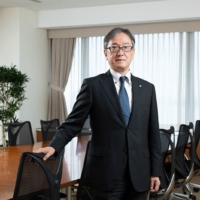Fashion photographer Aram Dikiciyan recognizes that his work is hard to define. "I can't really decide if I'm a fashion photographer or an artist," he explains over coffee in Tokyo's fashionable Omotesando district.
Our cozy table in this chic Parisian- style cafe overlooks a somber skyline of low gray clouds and rain sheeting down on grimy rooftops. Like the setting for our meeting, Dikiciyan's work — showing at the Clear Gallery in Shibuya till Feb. 14 — is both glamorous and gritty. Shot in grainy monochrome, the contrast in the sparsely composed images is so fierce that it almost obscures the clothes the models are wearing.
Although his photographs are the antithesis of the usual bright, glossy images used by the fashion industry, his work is sought after by a number of foreign style magazines, including New York's Big Man. MIXT(E) in Paris and Style in Berlin. He's also in demand with cult Japanese menswear labels such as The Viridi-anne, who employ him to showcase their work.
"It's very rare that a client can be satisfied with something that does not show the clothes at all," acknowledges Dikiciyan, who points out that the fabric's form does come out strongly in his work. "When you are only showing outlines, the cut of an outfit is very important, and that is what I like to show."
The 35-year-old photographer, who hails from West Berlin, started his career working as a photo editor at German street-culture bible Lodown, for which he eventually documented the street and skate scenes. In search of a radically different environment, he made the journey to Tokyo four and a half years ago. The move coincided with an introspective period, and as a way to seek relief from the darkness he felt, he began taking monochrome snapshots of Tokyo.
"I would carry my camera with me all the time, waiting for special moments, trying to snatch instants of beauty out of darkness, moments suspended between life and death. It was a difficult time, so I needed something to grab onto," he explains, dragging on a cigarette as he tries to frame precisely the emotions he was going through. "I believed strongly in something, a universal cosmic consciousness. In these special moments you could maybe see this one moment of beauty. That was my theme."
Dikiciyan insists that it was not the move to Japan that sparked this period of darkness, and emphasizes that he feels a lot of affinity with Japan.
"Germans have a heavy inheritance from the war, and the Japanese might have that as well. Germany is a very dark land, so things like music or art are very meaningful, but minimalist and beautiful," he muses. "The German winter can be ugly and dark, but it can be beautiful as well, and I'm very attracted to that."
In order to embrace minimalism, Dikiciyan began experimenting with his photography in a more controlled way by staging photographs with models and scouting interesting locations and lighting conditions.
"I'm attracted to the light of the full moon. It's very melancholic, which is why it always appears in my photography. The moon affects the whole earth, the human race, the ocean. I try hard to create an atmosphere that fits with the the moon's light," says Dikiciyan. "This was why it was so important for me to shoot with high-sensitive films. Even if I shoot in the studio, it is in almost total darkness with only a tiny blink of light so I can overexpose the film."
To enhance the already stark contrasts between light and dark, Dikiciyan manipulates the images by hand in the darkroom to get more contrast between blacks and whites.
"I'm very attracted by this simplicity. Simplicity is beauty," he says.
In order to pare his work further down to its bare bones, Dikiciyan has also stopped giving his photographs titles.
"I always used to have titles for the pictures and a whole theme for the exhibition. I stopped that because it's not about the theme. It's became more universal. I want to surprise people; it's good to give them space to think."
"Aram Dikiciyan: Photographien" is showing till Feb. 14 at the Clear Gallery, Place Aoyama, 4-2-5 Shibuya-ku; an 8-min. walk from Omotesando Station on the Chiyoda, Hanzomon and Ginza lines; open 11 a.m.-7 p.m. For more information, call (03) 5485-8461 or visit www.cleargallery.jp For info on upcoming exhibitions of Dikiciyan's photographs in March, visit www.aramdikiciyan.com
















With your current subscription plan you can comment on stories. However, before writing your first comment, please create a display name in the Profile section of your subscriber account page.